
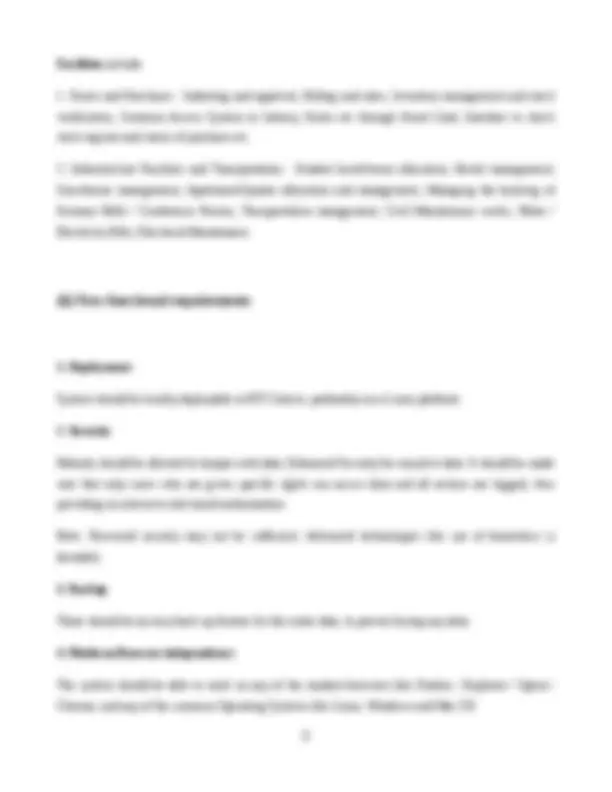
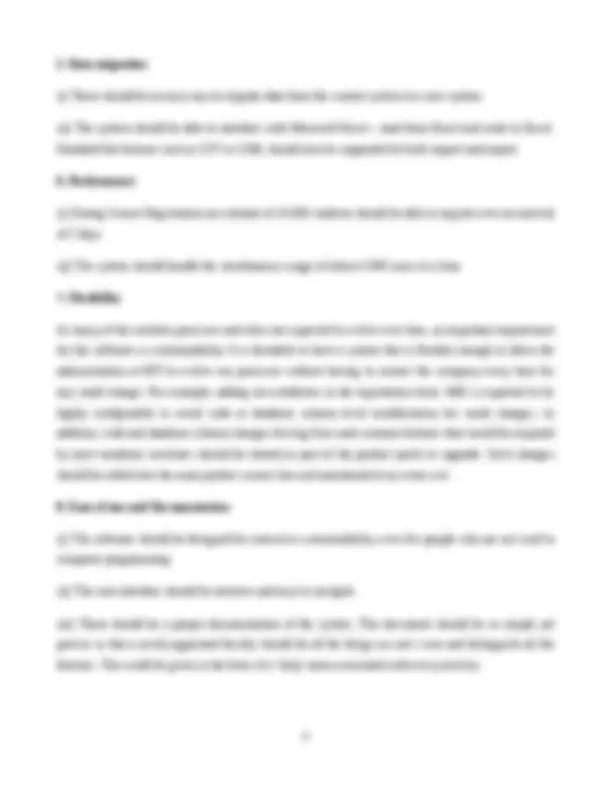
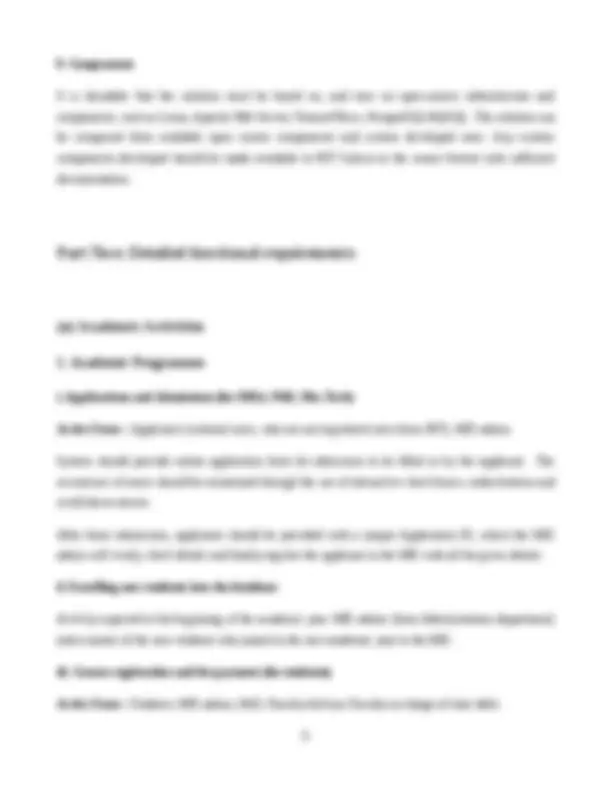
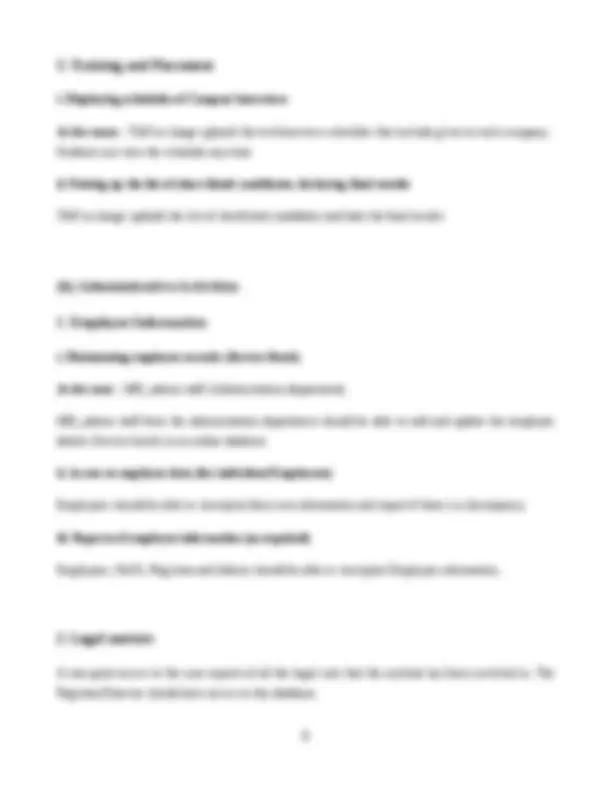
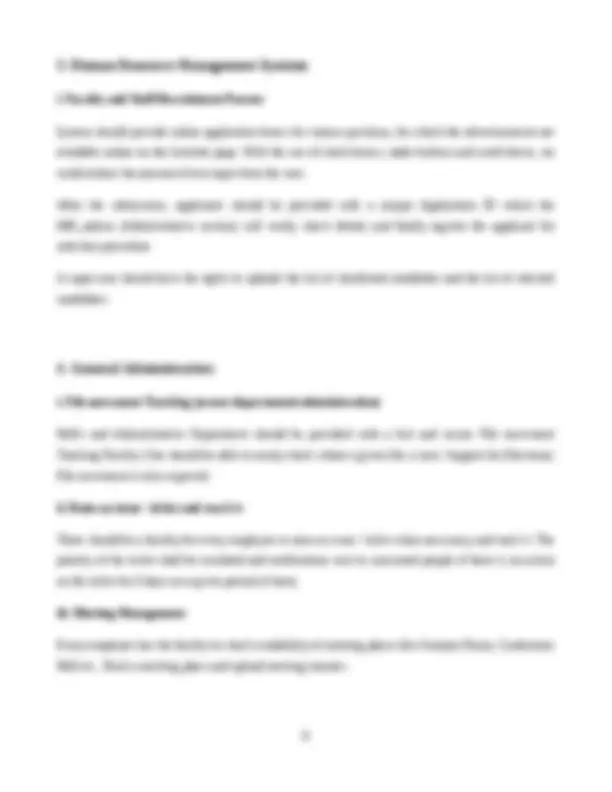
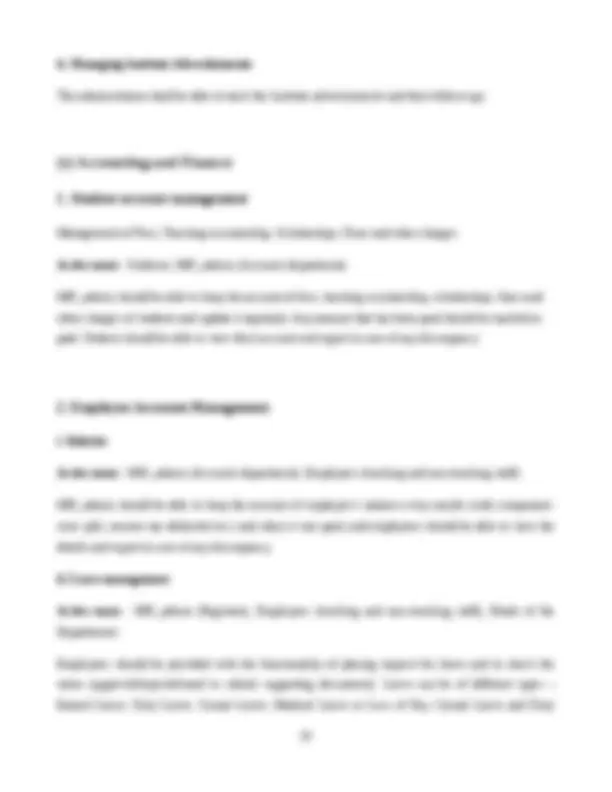
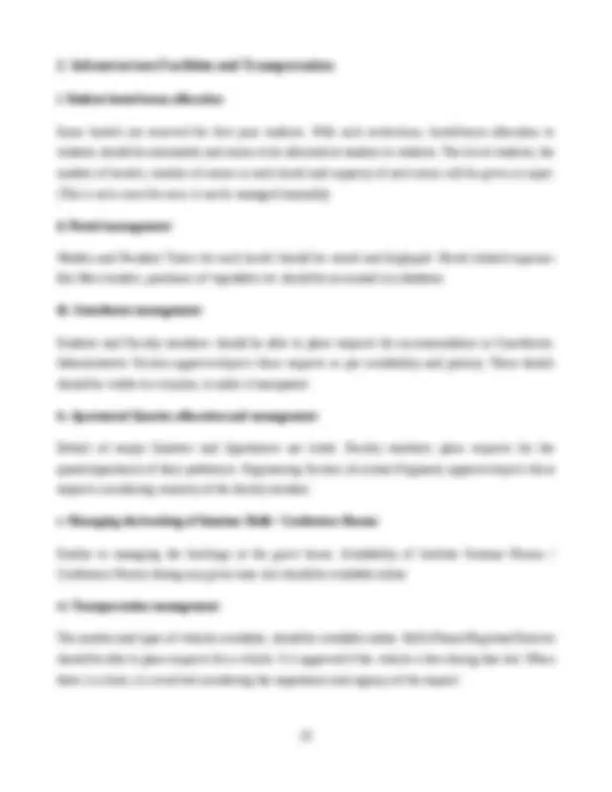
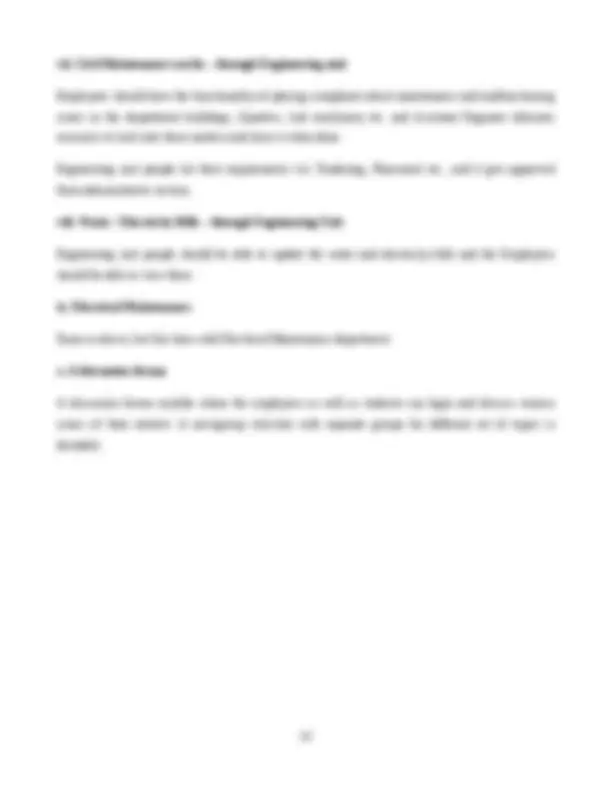


Study with the several resources on Docsity

Earn points by helping other students or get them with a premium plan


Prepare for your exams
Study with the several resources on Docsity

Earn points to download
Earn points by helping other students or get them with a premium plan
Community
Ask the community for help and clear up your study doubts
Discover the best universities in your country according to Docsity users
Free resources
Download our free guides on studying techniques, anxiety management strategies, and thesis advice from Docsity tutors
Part One: Top level requirements. (i) Functional Requirements. The system should support management of academic, administrative and other activities in our.
Typology: Lecture notes
1 / 14

This page cannot be seen from the preview
Don't miss anything!









National Institute of Technology, Calicut (NIT Calicut) is one of the leading research and academic institutes in engineering and science disciplines. At present, NIT Calicut has nearly 6000 students, 200 faculty members and about 250 non-teaching staff across 11 departments, 3 schools and 6 centres. NIT Calicut is seeking a software solution that automates various academic and administrative activities of the institute. The system will replace the decision support system software that is currently employed at the institute. This document gives specifications for the software, which will be refered to as Management Information System (MIS). Users of the campus automation software include students, faculty members, administrative staff members, and sometimes the general public who wish to access information about the institute. This document contains a minimal set of features / functionalities that the system must provide, and a set of non-functional requirements that the system must meet.
The system should support management of academic, administrative and other activities in our institute. These activities are divided into four sections as follows.
Academic activities include:
5. Data migration (i) There should be an easy way to migrate data from the current system to a new system. (ii) The system should be able to interface with Microsoft Excel – read from Excel and write to Excel. Standard file formats such as CSV or XML should also be supported for both import and export. 6. Performance (i) During Course Registration an estimate of 10,000 students should be able to register over an interval of 2 days. (ii) The system should handle the simultaneous usage of almost 1000 users at a time. 7. Flexibility As many of the institute processes and rules are expected to evolve over time, an important requirement for the software is customizability. It is desirable to have a system that is flexible enough to allow the administration at NIT to evolve our processes without having to contact the company every time for any small change. For example, adding new attributes in the registration form. MIS is expected to be highly configurable to avoid code or database schema level modifications for small changes. In addition, code and database schema changes for bug fixes and common features that would be required by most academic institutes should be treated as part of the product patch or upgrade. Such changes should be rolled into the main product source line and maintained at no extra cost. 8. Ease of use and Documentation (i) The software should be designed for extensive customizability, even for people who are not used to computer programming. (ii) The user-interface should be intuitive and easy to navigate. (iii) There should be a proper documentation of the system. This document should be so simple yet precise so that a newly appointed faculty should do all the things on one’s own and distinguish all the features. This could be given in the form of a ‘help’ menu associated with every activity.
9. Components It is desirable that the solution must be based on, and runs on open-source infrastructure and components, such as Linux, Apache Web Server, Tomcat/JBoss, PostgreSQL/MySQL. The solution can be composed from available open source components and custom developed ones. Any custom components developed should be made available to NIT Calicut in the source format with sufficient documentation.
i. Applications and Admissions (for MBA, PhD, Msc.Tech) Active Users : Applicants (external users, who are not registered users from NIT), MIS admin. System should provide online application form for admission to be filled in by the applicant. The occurrence of errors should be minimized through the use of interactive check-boxes, radio-buttons and scroll-down menus. After form submission, applicants should be provided with a unique Application ID, which the MIS admin will verify, check details and finally register the applicant in the MIS with all the given details. ii. Enrolling new students into the database Activity expected at the beginning of the academic year. MIS admin (from Administration department) enters names of the new students who joined in the new academic year to the MIS. iii. Course registration and fee payment (for students) Active Users : Students, MIS admin, HoD, Faculty Advisor, Faculty-in-charge of time table.
v. Viewing and Printing Grade Cards Active Users : MIS admin (academic department), Students. System should provide students who have logged into their accounts, the functionality of viewing their grade card. It should also provide MIS admin with the functionality of viewing and printing any student’s grade card. vi. Teacher evaluation Active users : Students and Faculty, Dean (UG) and Dean (PG). Students evaluate the faculty members based on the course they were offered in the last semester. Individual faculty members should be able to view their own report. Dean (UG) and Dean (PG) can view all the reports. The anonymity of the individual students should be ensured.
i. Student records management Active users : MIS_admin (Administration, NITC), Students. MIS_admin should be provided with the functionality of entering and updating the necessary student’s details like Name, Branch, Photograph, Batch, Roll number, Date of Birth, Blood Group etc. Students should be provided with the functionality of viewing their own records (password protected), filling up other optional detail fields like contact number, e-mail etc. and reporting to the MIS_admin in case any discrepancy occurs. Some of these fields should be available for internal viewing, while others are accessible only for those with admin status (Faculty, Faculty advisor and HoD). Details about the students currently enrolled to his/her course should be visible to the faculty. Similarly faculty advisor should have the same rights on all students under him/her. HoD should be able to view details of the students in the department.
i. Displaying schedules of Campus Interviews Active users : T&P in charge uploads the test/interview schedules that include given to each company. Students can view the schedule any time. ii. Putting up the list of short-listed candidates, declaring final results T&P in charge uploads the list of shortlisted candidates and later the final results. (b) Administrative Activities
i. Maintaining employee records (Service Book) Active user : MIS_admin staff (Administration department). MIS_admin staff from the administration department should be able to add and update the employee details (Service book) in an online database. ii. Access to employee data (for individual Employees) Employees should be able to view/print their own information and report if there is a discrepancy. iii. Reports of employee information (as required) Employees, HoDs, Registrar and Admin should be able to view/print Employee information.
A one-point access to the case reports of all the legal suits that the institute has been involved in. The Registrar/Director should have access to this database.
iv. Managing Institute Advertisements The administration shall be able to track the Institute advertisements and their follow-ups. (c) Accounting and Finance
Management of Fees, Teaching assistantship, Scholarships, Fines and other charges. Active users : Students, MIS_admin (Accounts department). MIS_admin should be able to keep the account of fees, teaching assistantship, scholarships, fines and other charges of students and update it regularly. Any amount that has been paid should be marked as paid. Student should be able to view their account and report in case of any discrepancy.
i. Salaries Active users : MIS_admin (Accounts department), Employees (teaching and non-teaching staff). MIS_admin should be able to keep the account of employee’s salaries every month (with component- wise split, income tax deducted etc.) and when it was paid, and employees should be able to view the details and report in case of any discrepancy. ii. Leave management Active users : MIS_admin (Registrar), Employees (teaching and non–teaching staff), Heads of the Departments. Employees should be provided with the functionality of placing request for leave and to check the status (approved/rejected/need to submit supporting documents). Leave can be of different types – Earned Leave, Duty Leave, Casual Leave, Medical Leave or Loss of Pay. Casual Leave and Duty
Leave can be approved by the Head of the Department. Other approvals come from the Registrar. iii. Income Tax management Active users : MIS_admin (Accounts department), Employees (teaching and non-teaching staff). Employees should be able to enter details of the investments that they make, Insurance policies, Housing Loans etc; MIS_admin should be able to keep the account of these investments that each employee makes, income tax relaxations that each employee is entitled to in each section (like 80C) and the income tax deductions from salary every month. Employees should be able to view the details and report in case of any discrepancy. iv. Pension management Similar to Salary management, but for retired employees. v. TA/DA and PDA Similar to Salary management, but only when there is a need to approve TA/DA/PDA to employees. Salaries, Leave management, Income Tax management, Pension management, TA/DA and PDA.
i. Visibility and transparency of various funds across departments, projects, interest groups, Deans, Registrar and the Director. Records should be available online for any such expenditure, and should be easily verifiable. ii. Compilation of accounts to enable furnishing details of expenditure to the funding agencies. Active users : MIS_admin (Administrative department), Faculty, Heads of the Departments. Faculty and HoD should be able to fill in the details of expenditure for any project that they are part of, so that this data can be compiled and sent to Funding Agencies for funding a project.
i. Student hostel/room allocation Some hostels are reserved for first year students. With such restrictions, hostel/room allocation to students should be automated, and rooms to be allocated at random to students. The list of students, the number of hostels, number of rooms in each hostel and capacity of each room will be given as input. (This is not a must for now, it can be managed manually). ii. Hostel management Warden and Resident Tutors for each hostel should be stored and displayed. Hostel related expenses like Mess tenders, purchases of vegetables etc should be accounted in a database. iii. Guesthouse management Students and Faculty members should be able to place requests for accommodation in Guesthouse. Administrative Section approves/rejects these requests as per availability and priority. These details should be visible to everyone, to make it transparent. iv. Apartment/Quarter allocation and management Details of empty Quarters and Apartments are listed. Faculty members place requests for the quarter/apartment of their preference. Engineering Section (Assistant Engineer) approves/rejects these requests considering seniority of the faculty member. v. Managing the booking of Seminar Halls / Conference Rooms Similar to managing the bookings at the guest house. Availability of Institute Seminar Rooms / Conference Rooms during any given time slot should be available online. vi. Transportation management The number and types of vehicles available, should be available online. HoDs/Deans/Registrar/Director should be able to place requests for a vehicle. It is approved if the vehicle is free during that slot. When there is a clash, it is resolved considering the importance and urgency of the request.
vii. Civil Maintenance works – through Engineering unit Employees should have the functionality of placing complaints about maintenance and malfunctioning issues in the department buildings, Quarters, Lab machinery etc. and Assistant Engineer allocates resources to look into these matters and close it when done. Engineering unit people list their requirements viz. Tendering, Placement etc., and it gets approved from administrative section. viii. Water / Electricity Bills – through Engineering Unit Engineering unit people should be able to update the water and electricity bills and the Employees should be able to view them. ix. Electrical Maintenance Same as above, but this time with Electrical Maintenance department. x. A discussion forum A discussion forum module where the employees as well as students can login and discuss various issues of their interest. A newsgroup structure with separate groups for different set of topics is desirable.